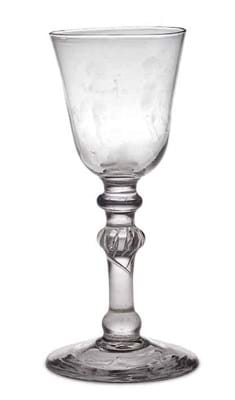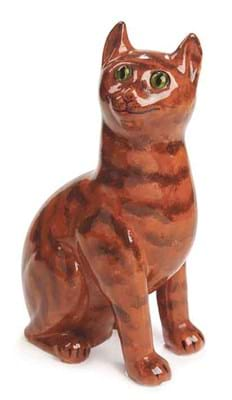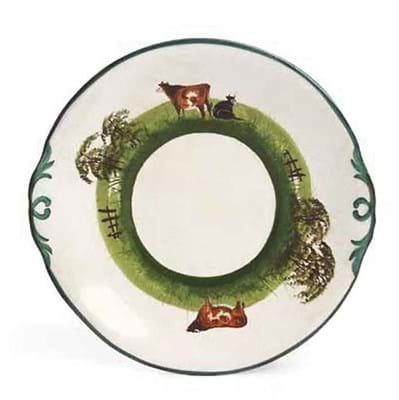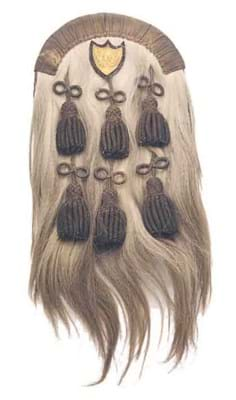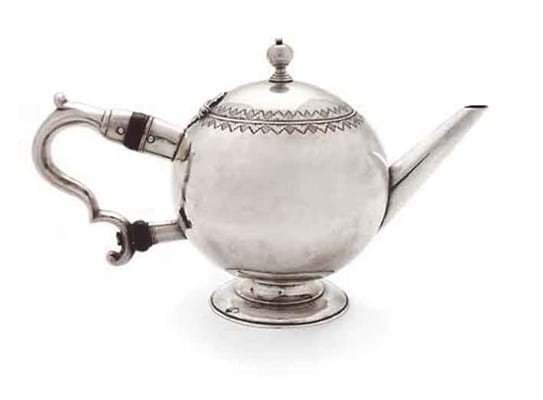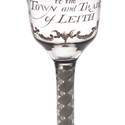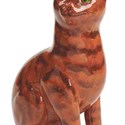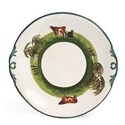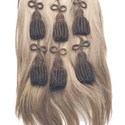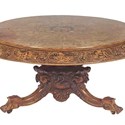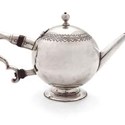And they pulled it off.
The roots of Drambuie - the name is taken from the Gaelic meaning "the drink that satisfies" - can be directly traced to 1746 when legend has it Bonnie Prince Charlie bequeathed to Captain John MacKinnon of Skye the recipe for a scotch whisky liqueur as gratitude for the protection from the British Army after Culloden. The MacKinnon family, now Edinburgh based, remain the owners of Drambuie.
The roots of the Drambuie collection are not so deep - 20 years of acquisition through salerooms and dealers designed to enrich the brand and transform the Edinburgh corporate headquarters into art gallery. Robin Nicholson, who formerly worked at The Fine Art Society in Edinburgh, has been the principal advisor to the MacKinnon family and was appointed curator of the collection in 1992.
At the heart of the collection is a celebrated archive of Jacobite relics which remains key to the brand.
However, the need to rationalise the company's assets during one of the most turbulent trading periods in its 260-year history has made associated acquisitions surplus to requirements.
Up for grabs was an A-Z assembly of Scottish art, a significant collection of Scottish pottery, silver and boardroom furniture - and an opportunity for L&T to conduct the sort of showpiece sale by which reputations are made.
Pictures
When the marketing campaign finally took a breather on the evening of January 26, there can't have been many potential bidders who weren't aware that this year Drambuie was not just for drinking on Burn's Night. In financial terms, the sale was all about the pictures.
Samuel John Peploe's still life of pink roses and fruit c.1919, estimated at £100,000-150,000, drew a fierce battle quickly between the room and the phone, the latter winning at an impressive £220,000
Elsewhere there were a series of strong prices and the sole disappointment of the evening was the much hyped Sir William Quiller Orchardson RA (1832-1910) oil Dolce Far Niente. Estimated at £30,000-40,000, it got away just over the opening bid at £16,000 to a delighted lady buyer in the room.
Antiques
So it must have been with some relief that John Mackie took to the rostrum on January 27 in the knowledge that, at £2.64m, the running sale total was already up on the projected take for the collection.
Drambuie Part II was worth a further £520,000, enough for L&T to claim the biggest single sale total posted by a regional auction house at £3.16m.
The Wemyss was particularly good. "Fashions have come and gone, but Wemyss has retained an enthusiastic following of discerning collectors who cherish its distinctive charm and superb painting," wrote specialists Victoria de Rin and David MacMillan in a forward to the catalogue.
Certainly the market proved capable of sustaining the dizzy price levels achieved for rare pigs and cats at recent Sotheby's sales in Gleneagles. Predictably, the favourite at Edinburgh was a 12.5in (32cm) high tabby cat, modelled, Gallé-style, in a seated upright position with smiling face and applied with green glass eyes.
The form comes in a wide variety of different decorative treatments from monochromes to cabbage roses but the naturalistic tones of the tabby is certainly among the most appealing. Eight out of ten Wemyss collectors said they preferred it - and bidding shot to a quadruple upper-estimate £20,000.
This bid matches that offered for a cat decorated with circles and hearts in green against a pink ground at Sotheby's in 2003.
The record for Wemyss remains the remarkable £29,000 (plus 20 per cent premium) bid twice for two super-cute sleeping piglets at Gleneagles in 2004. However, £20,000 is a massive price for a Wemyss tabby, one of which made £9500 at Gleneagles as recently as 2001.
The other Drambuie Wemyss cats of the same form but more standard decoration (there were five in total) proved more predictable. Two glazed in apple green sold at £3200 while another with pink cabbage roses, but some damage, achieved £3800.
Two rare tablewares, both decorated with farm animals and both probably by Karol Nekola, performed well. A bread-and-butter plate painted with a frieze of cows and a bull in a landscape had some minor damage but sold at £1600 against an estimate of £300-500. Another bid of £1600 secured a 7.5in (19cm) square tray painted with a solitary black pig within a green scalloped border that also had a fine hairline.
There were several examples of the well-known honeycomb pots, but more unusual was an example modelled as a bee skep with 'thatched' cover and painted with flying bees. Estimated at £800-1200, it sold at £1900.
Winning Consignment
L&T had been a dogfight to win this job from local rivals - single-owner consignments as good as this one don't just fall into the lap - but, once chosen to conduct the sale, they were not asked to hike estimates to testing levels. Guidelines for a fine array of 18th century drinking glasses put little pressure on the market.
The Leith Goblet, was the title given to a 7.75in (19cm) high bucket-bowl glass decorated in white enamel with a rococo scroll cartouche enclosing the dedication The Success to the Town and Trade of Leith. The traditional attribution of these wares is to the Beilby family of Newcastle and the suggestion was made that the goblet was probably made and gifted to wish success to a trade venture between Newcastle and Leith merchants.
There is an alternative theory. I recall an article by museum curator turned Sotheby's specialist Simon Cottle in which he raised the probability of similar enamelling workshops operating in Scotland c.1765. Could this be one of those wares? Anyway it doubled hopes when it sold at £11,000.
A very fine Dutch decorated 'Newcastle' composite stemmed cordial glass, c.1760 took £7500 (estimate £4000-6000). The 7in (17.5cm) high glass was the The Friendship pattern from a series also depicting The Liberty, Peace, Harmony and Fatherland and was stipple engraved with three (rather than the usual two) putti drinking a toast. The inscription below the rim of a Dutch-decorated light baluster translates as The Success to the voyage of the Boeken Roode. She was built as a 52-gun ship in 1729 in Amsterdam and refitted in 1747 as the 44-gun three-masted ship engraved to the funnel bowl.
Engraved to the reverse were the arms of Roos of Amsterdam suggesting the goblet was made to mark Dirk Roos's promotion to Rear Admiral in 1748. Standing a substantial 10in (25cm) high, it sold at a mid-estimate £5500.
Silver
Drambuie's silver holdings were relatively small but did include a classic Scottish teapot from the early years of George II's reign.
Both the spherical or 'bullet' form and the restrained narrow band of engraved decoration around the shoulder are characteristic of Scottish hollowware of this period.
This 6.25in (16cm) high, 22.5oz example from 1729 was marked for Edinburgh maker James Taitt, who might just be the jeweller and silversmith called 'Tate' who accompanied Prince Charles Edward Stuart back to France in 1746. It sold at £3200 (estimate £1500-2000).
A William IV punch ladle with marks for William Cunningham of Edinburgh, 1830 was set to the floral engraved bowl with a gilt coin inscribed Georgius II. Popular legend associates coin-inset punch ladles such as this fine example, with the Jacobite cause as each serving presented an opportunity to 'drown' a Hanoverian monarch in the punch. They are not, however, uncommon, so £1200 - against an estimate of £200-300 - looked a strong bid.
Sporrans
Scottishness was what the Drambuie collection was all about. And what could be more Scottish than the sporran?
There were many examples here including a regimental sporran inscribed 42 (for the 42nd Highlanders) and mounted to the grey horsehair body with six gold bullion work tassels suspended from single-knotted gold cords. The 20in (51cm) sporran was estimated low but sold at £2300.
Another officer's regimental dress sporran with a similar display of gold bullion wirework tassels and comparable in terms of size, had a central oval crest inscribed The Queen's Own Cameron Highlanders above a banner inscribed Peninsula, Egypt, Waterloo. The purse was inscribed to the reverse R&HB Kirkwood, 66 & 68 Thistle Street,
Edinburgh. It made £1900.
But perhaps most interesting of the trio was the late 17th/early 18th century, brass-mounted leather sporran measuring just 81/2in (21cm) long and embellished only with crudely engraved stylised thistles, the saltire of St Andrew and a monogram.
It was one of two early sporrans in the sale (another sold at £1100) but this was accompanied by a note stating: 'Sporran left behind at Barcaldine by Macdonald of Glencoe where he had been storm-stayed by snow in December 1691. Consequently he was two days late in reaching Inveraray to sign the Oath of Allegiance by 1st January 1692, which gave Campbell of Glenlyon the excuse for the Massacre of Glencoe'.
That was enough to see it double the mid-estimate and take £2600.
Furniture
What followed was an array of Georgian and Victorian boardroom furniture and associated furnishings from stuffed fish to Thorneycroft bronzes, Aubusson tapestry fragments and model yachts. Private buying dominated.
The furniture yielded one exceptional object - a mid Victorian walnut centre table, attributed to Henry Eyles of Bath.
It was difficult to know where to look first. To the 5ft 3in (1.60m) diameter, burr quarter-veneered top was a cartouche-shaped marquetry panel depicting a basket of flowers. To the sloping boxwood frieze were 16 reliefcarved oval panels depicting the Ages of Man and Adam and Eve expelled from Paradise, between rope twist mouldings. And the base was a riot of carved dolphins, flowers, shells and swans.
A similar table by Henry Eyles (it is likely that the edge carving was carried out by his relation George Eyles, woodcarver of Claverton Street, Bath) was exhibited at The Great Exhibition of 1851 and is now in the Victoria & Albert Museum. The subject matter suggests the Drambuie table was also made for exhibition. Estimated at £8000-12,000, it pushed on to £34,000.
Drambuie is a shot in the arm for the Scottish art market and - in their quest for a larger slice of that cake - Lyon & Turnbull appear to have done themselves no harm at all.
The buyer's premium was 19.5/12%.


